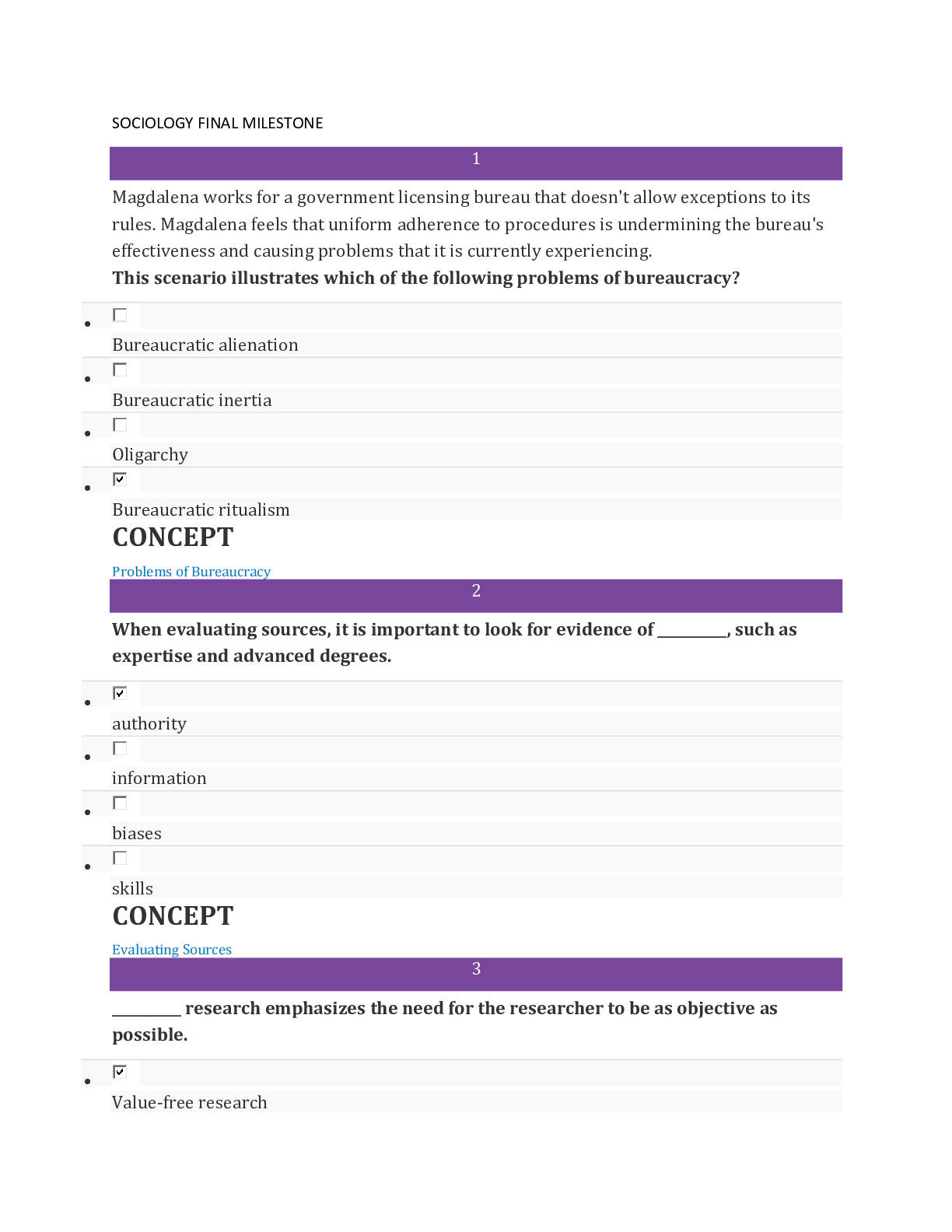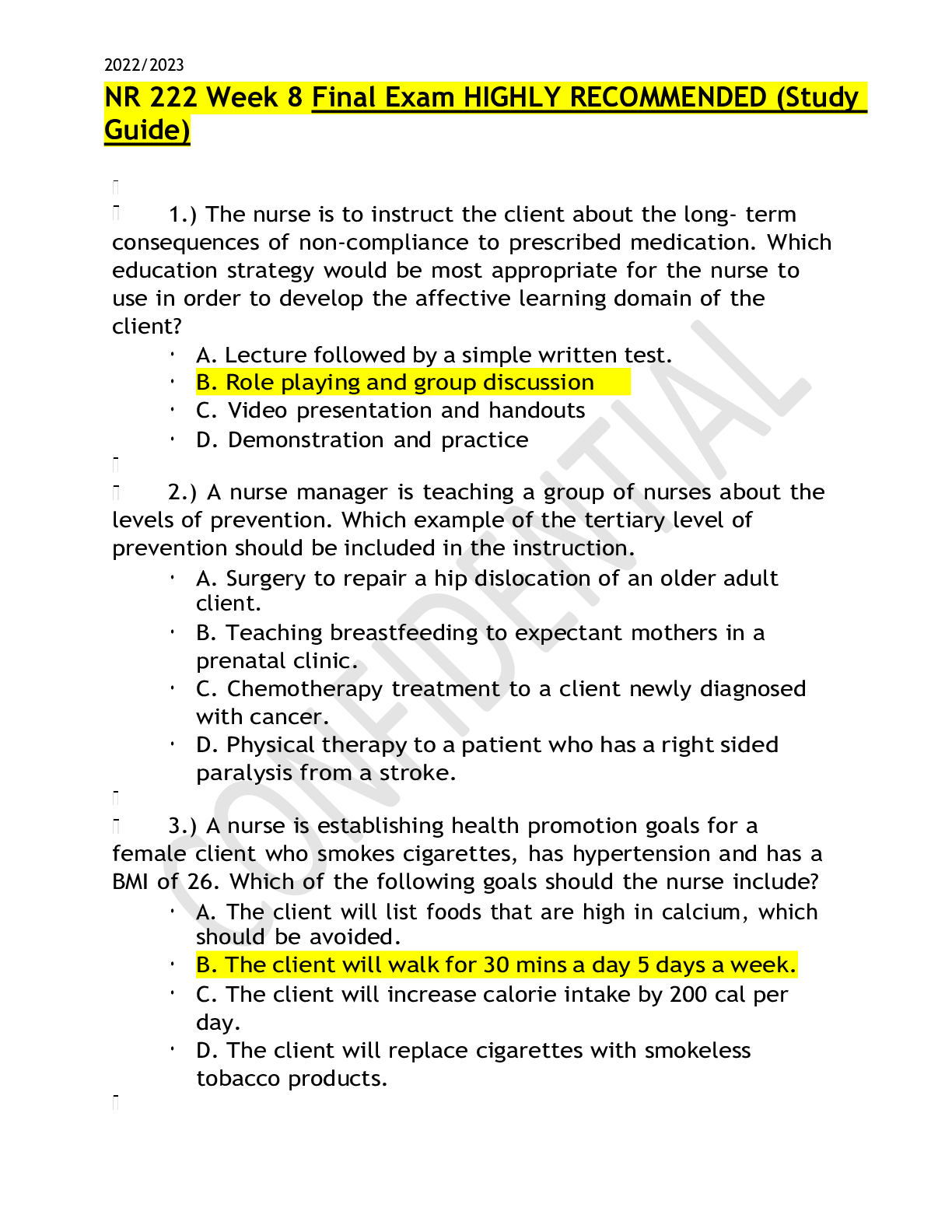AGNP Board Exam Question and Answers - Dermatology Prescription
Document Content and Description Below
AGNP BOARD EXAM: Dermatology Prescription (100 Questions and Answers) 1. Systemic ivermectin (Stromectol), classified as an antiparasitic,: 2. Topical permethrin (Elimite) in the treatment of sc... abies should be left in place for a minimum of: 3. The mechanism of action of clindamycin (Cleocin), used in the treatment of cellulitis, is to: 4. Tretinoin topical (Retin-A) is indicated for the treatment of acne vulgaris and: 5. The brand name of oral isotretinoin is: 6. Benzoyl peroxide (Benzac wash) is classified as a topical: 7. The generic name for Elidel is: 8. Which of the following conditions is NOT a side effect of long-term use of topical steroids? 9. Patients using fluorouracil (Carac) for the treatment of actinic keratosis should be advised to expect: 10. Tetracycline (Sumycin) is used in the treatment of skin and skin structure infections caused by: 11. The most appropriate therapy for patients with chronic paronychia is a: 12. The use of tetracycline in children younger than 9 years with a bacterial skin infection, may cause: 13. Daily doses of oral corticosteroids, such as prednisone, should be administered: 14. The mechanism of action of sulfa agents, in the treatment of cellulitis, is to: 15. Topical salicylic acid, a keratolytic: 16. Retapamulin (Altabax), used in the treatment of impetigo, is NOT: 17. Initial treatment for irritant contact dermatitis is a: 18. The brand name of clindamycin and benzoyl peroxide topical for the treatment of acne is: 19. Dosage reductions should be considered when prescribing first-generation cephalosporins for patients with: 20. Diclofenac (Solaraze), a topical anti-inflammatory, is used in the treatment of: 21. Antiviral agents for the treatment of herpes zoster: 22. A side effect of benzoyl peroxide (Benzac wash) is: 23. Which of the following is NOT appropriate advice for the patient using benzoyl peroxide (Benzagel)? 24. Clindamycin (Cleocin) should NOT be administered with: 25. Moderate irritant contact dermatitis to the face should be treated with a: 26. Patients treated with sulfamethoxazole and trimethoprim (Bactrim) should be advised to take it: 27. A breastfed infant has been diagnosed with oral candidiasis. Which of the following statements is true? 28. Fluorouracil (Carac), for treatment of actinic keratosis, is classified as a(n): 29. Ciclopirox (Loprox) shampoo for the treatment of seborrheic dermatitis should be applied: 30. Which of the following antibiotics is NOT approved for the treatment of acne vulgaris? 31. The greatest concern with long-term use of topical corticosteroids is: 32. Patients with comedonal noninflammatory acne should be treated with a topical: 33. Dynacin, used in the treatment of skin infections, is the brand name for: 34. Tretinoin topical gel (Atralin) should be used cautiously in patients who are allergic to: 35. A patient received a prescription for clindamycin/benzoyl peroxide topical with orders to dispense 2 containers. Until ready for the use, the patient should store the additional container: 36. Given the same percentage and type of topical corticosteroid, the vehicle with the highest potency would be the: 37. Patients should be advised that clindamycin (Cleocin) should be administered with: 38. The body surface area with the LEAST ability to absorb topical steroids is: 39. The most troublesome adverse reaction to clindamycin (Cleocin), used in the treatment of cellulitis, is: 40. The best treatment for mild cellulitis caused by methicillin-resistant Staphylococcus aureus is: 41. The preferred treatment for Lyme disease in a 16-year-old male is: 42. The most effective way to assure that the patient has enough topical corticosteroid for the duration of treatment is to: 43. Which of the following medications for the treatment of acne is extended-release and is dosed according to weight? 44. To assure maximum efficacy in the treatment of actinic keratosis, fluorouracil (Carac) should be applied for at least: 45. A 23-year-old man has completed 12 weeks of therapy with clindamycin/benzoyl peroxide topical for acne. He should be advised to return immediately if he develops: 46. Due to potential systemic absorption, the use of fluorouracil (Carac) should be avoided in patients who: 47. Topical corticosteroids, used to treat various skin conditions,: 48. Patients should be advised that after an intralesional corticosteroid injection, they should expect: 49. Imiquimod (Aldara) is indicated for the treatment of: 50. Benzoyl peroxide (Benzagel) is indicated for the treatment of: 51. Patients using diclofenac (Solaraze) should be advised to expect optimal therapeutic effect of actinic keratoses within: 52. Which statement about the action of silver sulfadiazine (Silvadene) cream is TRUE? 53. A potential systemic reaction to imiquimod (Aldara), used to treat superficial basal cell carcinomas, is: 54. Patients with seborrheic dermatitis who have patchy, orange to salmon-colored plaques covered with scales should be treated with: 55. Intralesional corticosteroid injections should NOT be: 56. Laboratory monitoring for a patient on cephalexin (Keflex) should include: 57. Prednisolone topical cream belongs to which of the following drug classes? 58. Silver sulfadiazine (Silvadene) cream, indicated for the treatment of burns, is: 59. The use of silver sulfadiazine (Silvadene) cream should be avoided in: 60. Dapsone (Aczone) topical 5% gel should be applied: 61. The recommended first-line treatment of tinea capitis in a 5-year-old child is: 62. Patients applying low-potency steroids to the face should be instructed to: 63. Lidocaine (Lidoderm) patch should NOT be prescribed for patients allergic to: 64. Topical permethrin should be avoided in patients with an allergy to: 65. The most effective therapies in the treatment of acne related to increased sebum production are: 66. A potential adverse reaction related to the use of sulfacetamide (Klaron) topical, indicated for the treatment of seborrheic dermatitis, is: 67. The addition of epinephrine to lidocaine hydrochloride: 68. High-potency topical corticosteroids: 69. First-generation cephalosporins for the treatment of bacterial skin infections: 70. Which of the following is NOT a topical pediculicide? 71. Pediatric patients are at greater risk than adults for developing adrenal suppression related to topical steroid use due to their: 72. The patient receiving imiquimod (Aldara) topical for the treatment of actinic keratosis should be instructed to apply: 73. A combination topical antimicrobial-antibiotic medication used in the treatment of acne is: 74. Children receiving griseofulvin (Grifulvin V) for the treatment of tinea capitis should be monitored for: 75. Which of the following statements about systemic clindamycin (Cleocin) is true? 76. Sulfamethoxazole and trimethoprim (Bactrim) should NOT be prescribed for patients who: 77. The best medication choice for the treatment of acne in hairy areas is: 78. An example of a first-generation cephalosporin is: 79. The half life of trimethoprim-sulfamethoxazole (Bactrim DS) is approximately: 80. Zinc oxide is indicated in the treatment of: 81. A treatment regimen for acne will only be considered ineffective after consistent adherence for at least: 82. Severe nodular acne should be treated with: 83. Patients receiving imiquimod (Aldara) should not receive: 84. Zinc oxide, for the treatment of diaper dermatitis, is classified as a(n): 85. Instructions given to patients being treated with Silver sulfadiazine (Silvadene) cream should NOT include: 86. A patient with psoriasis has a salicylic acid sensitivity and should be instructed to avoid: 87. The initial recommended therapy for patients with moderate postherpetic neuralgia is: 88. Capsaicin topical cream, used to relieve pain related to herpes zoster,: 89. The steps to correctly apply topical permethrin (Nix) in the treatment of pediculosis capitis is to: 90. When administering cephalexin (Keflex) suspension, sometimes used in the treatment of acne vulgaris,: 91. The mechanism of action of oral antifungal agents, used in the treatment of tinea corporis, is to: 92. Oral antibiotics for the treatment of acne vulgaris: 93. The best choice for the relief of painful oral lesions associated with hand foot and mouth disease in children is: 94. Imiquimod (Aldara) is classified as a topical: 95. Pimecrolimus (Elidel) is classified as a topical: 96. Gabapentin (Neurontin), indicated in the treatment of postherpetic neuralgia,: 97. The Fingertip Unit (FTU) method is used when prescribing topical medications. If one arm equals 3 fingertips, approximately how many grams will need to be prescribed for a man who needs BID application to one arm for 7 days? 98. To enhance absorption, tetracycline should be administered: 99. Pimecrolimus (Elidel) is indicated in the treatment of: 100. The generic name for Mycostatin is: [Show More]
Last updated: 1 year ago
Preview 1 out of 38 pages
Instant download
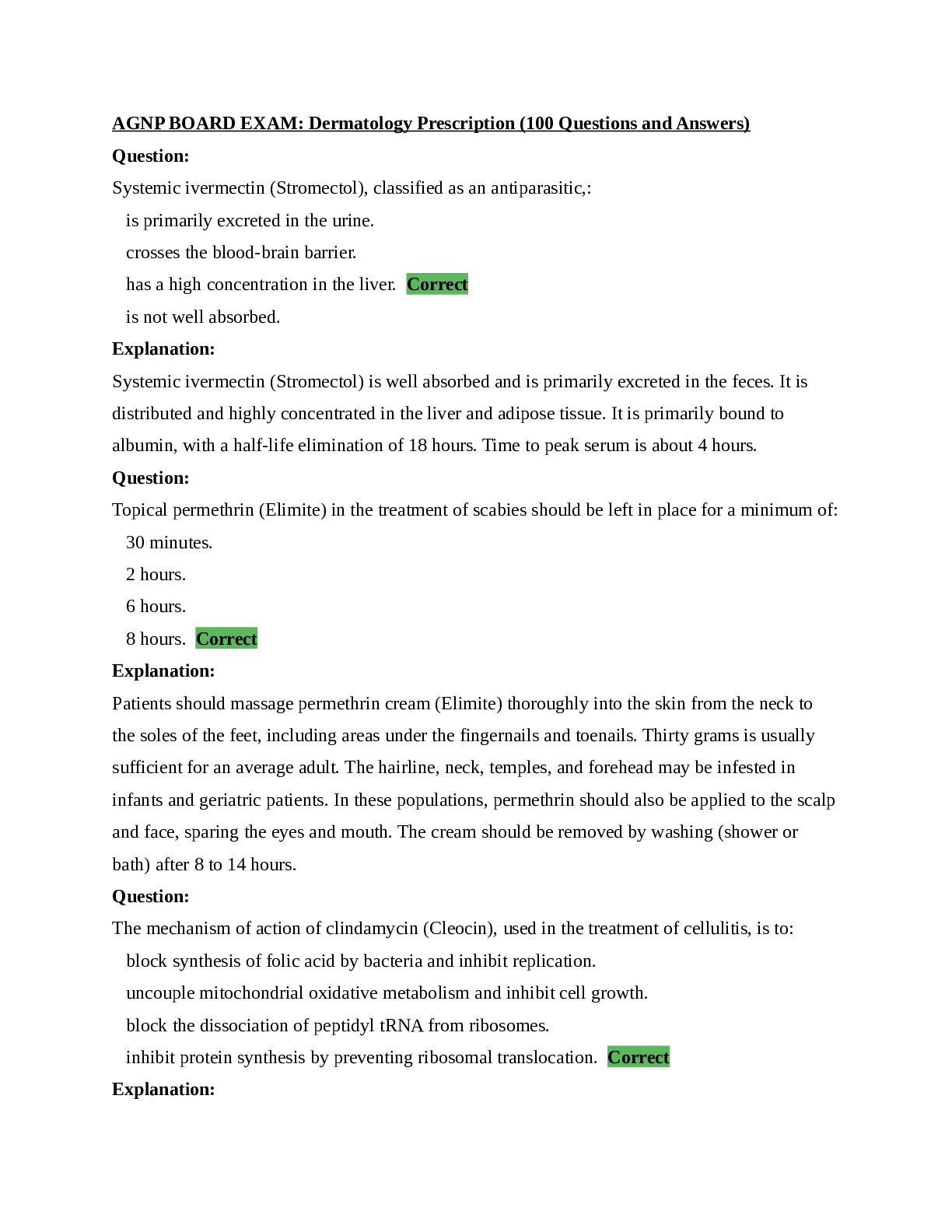
Buy this document to get the full access instantly
Instant Download Access after purchase
Add to cartInstant download
Reviews( 0 )
Document information
Connected school, study & course
About the document
Uploaded On
Sep 30, 2021
Number of pages
38
Written in
Additional information
This document has been written for:
Uploaded
Sep 30, 2021
Downloads
0
Views
37

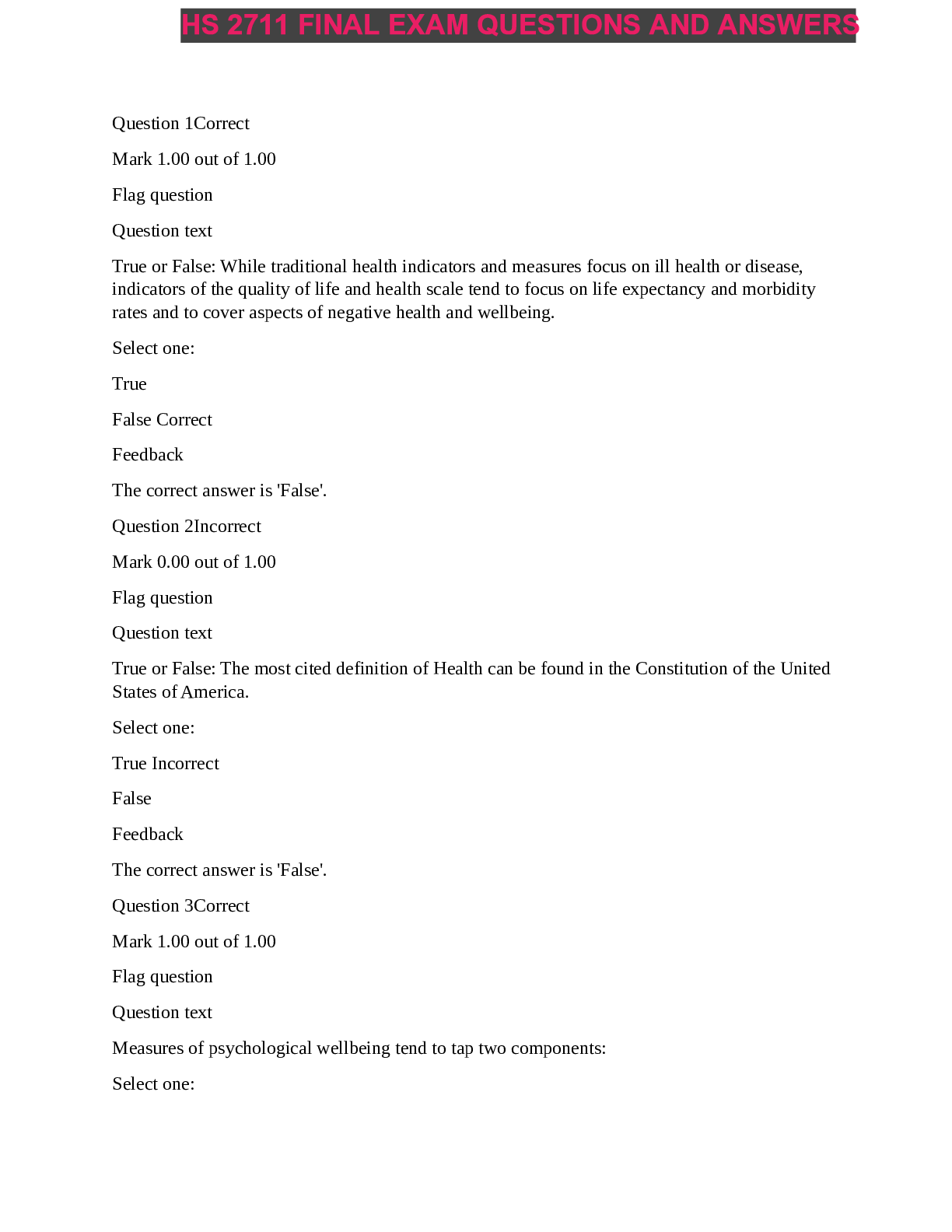
.png)
.png)
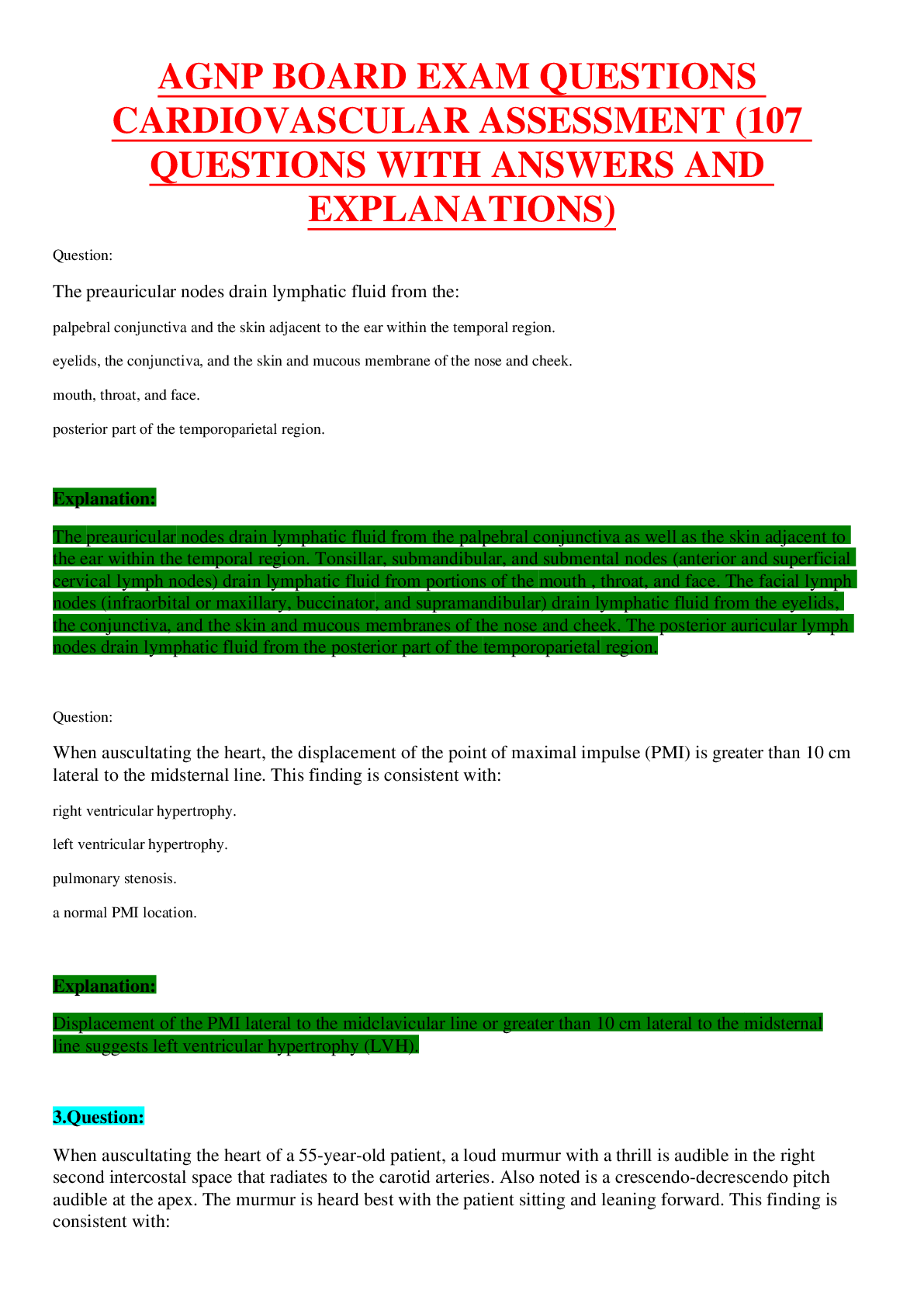
.png)

.png)
.png)
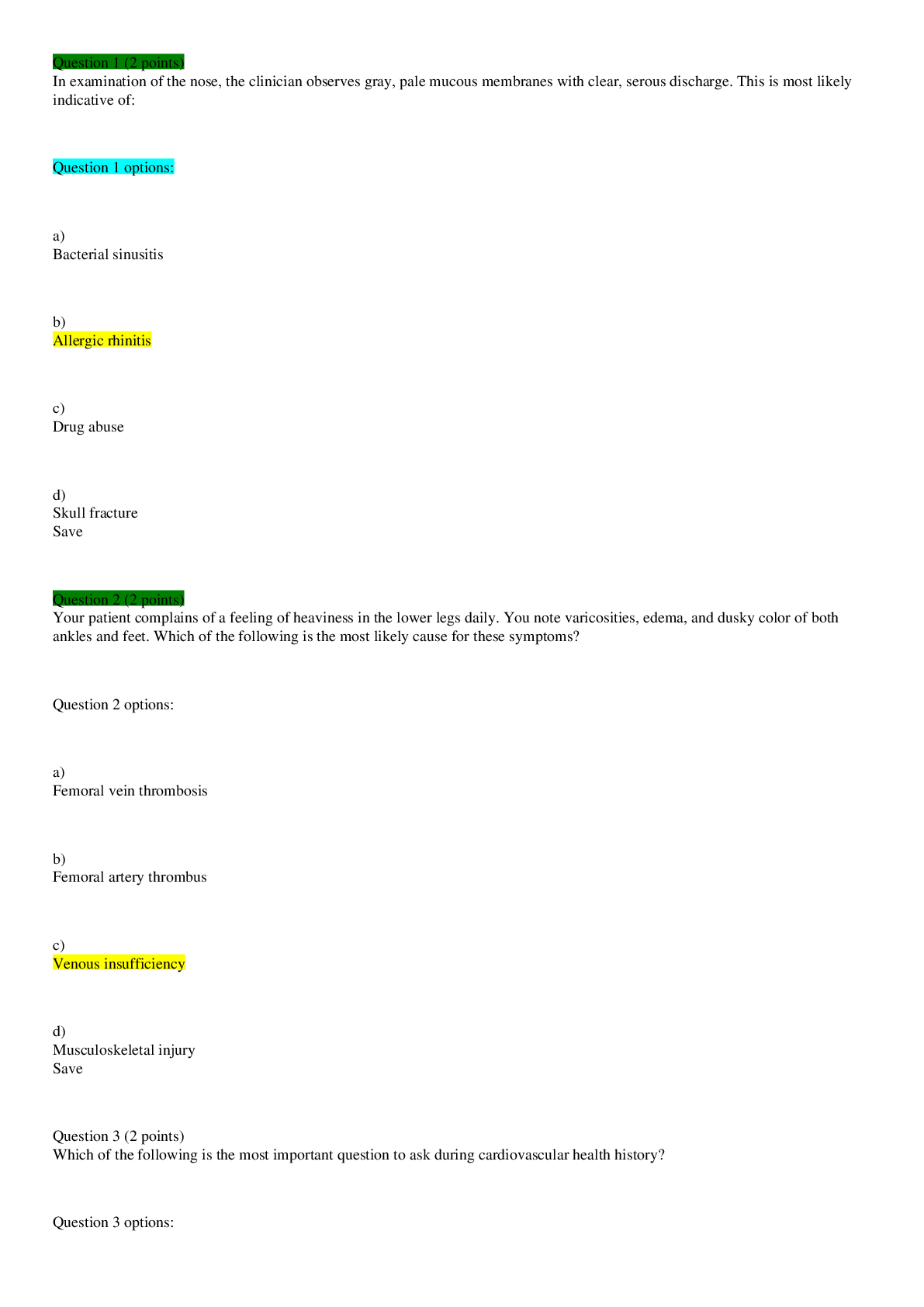
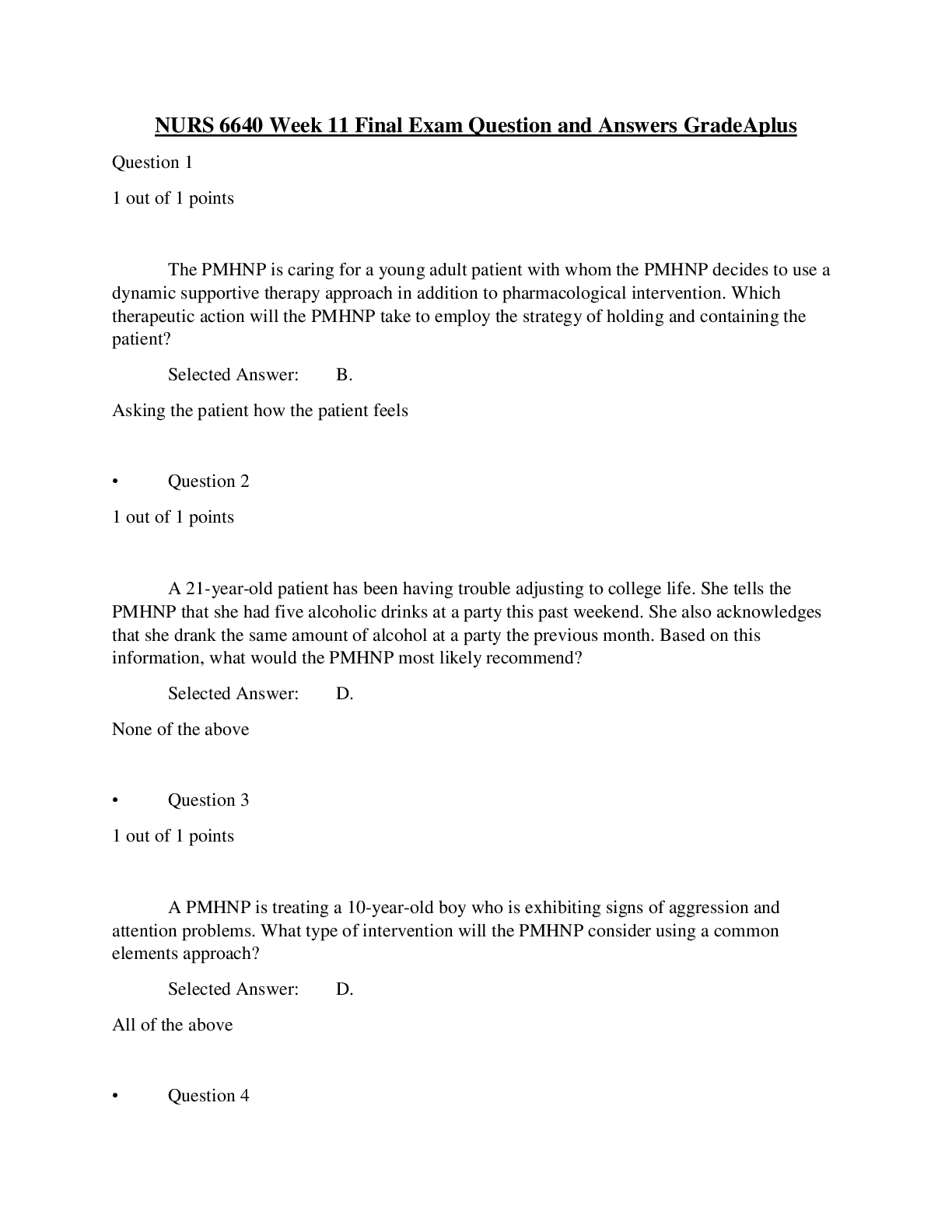
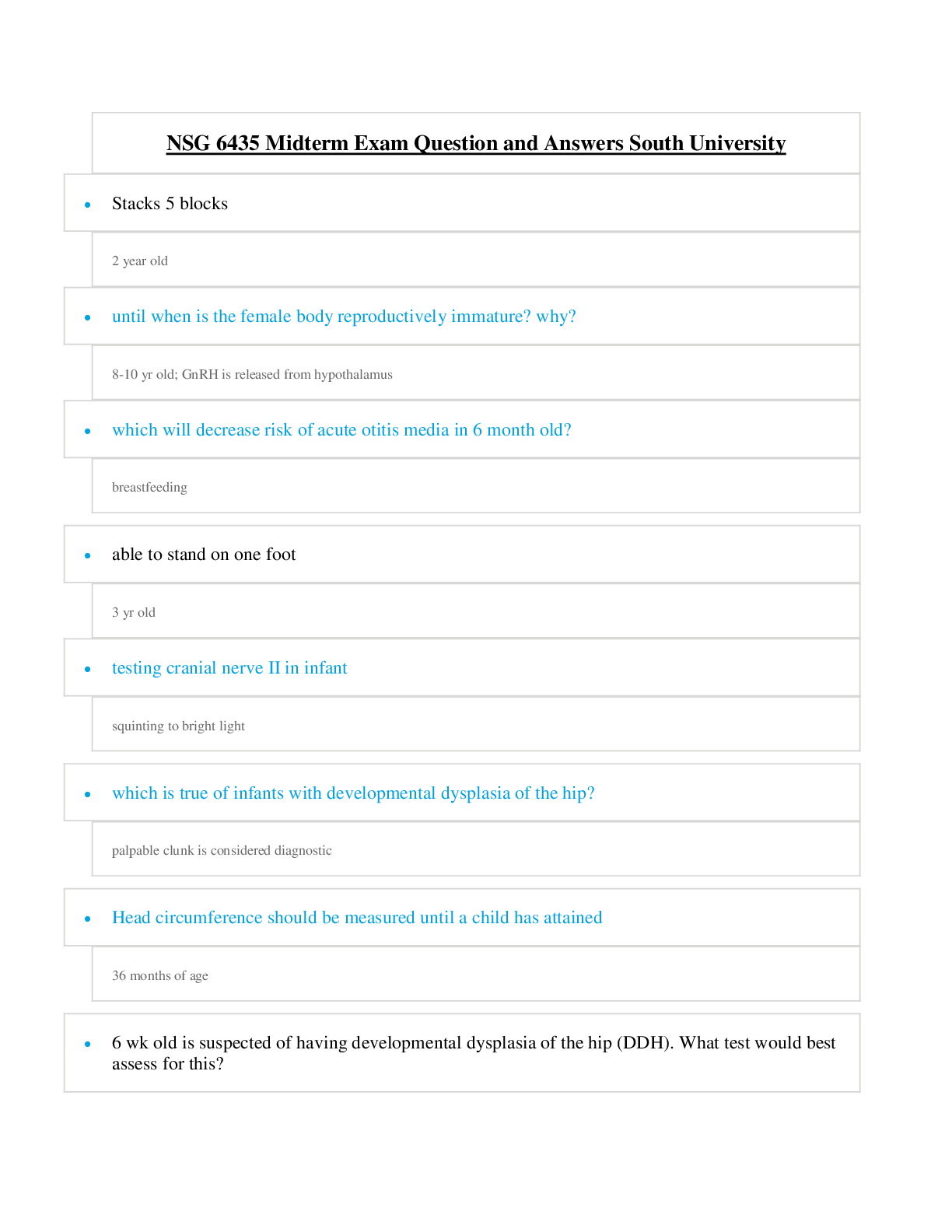
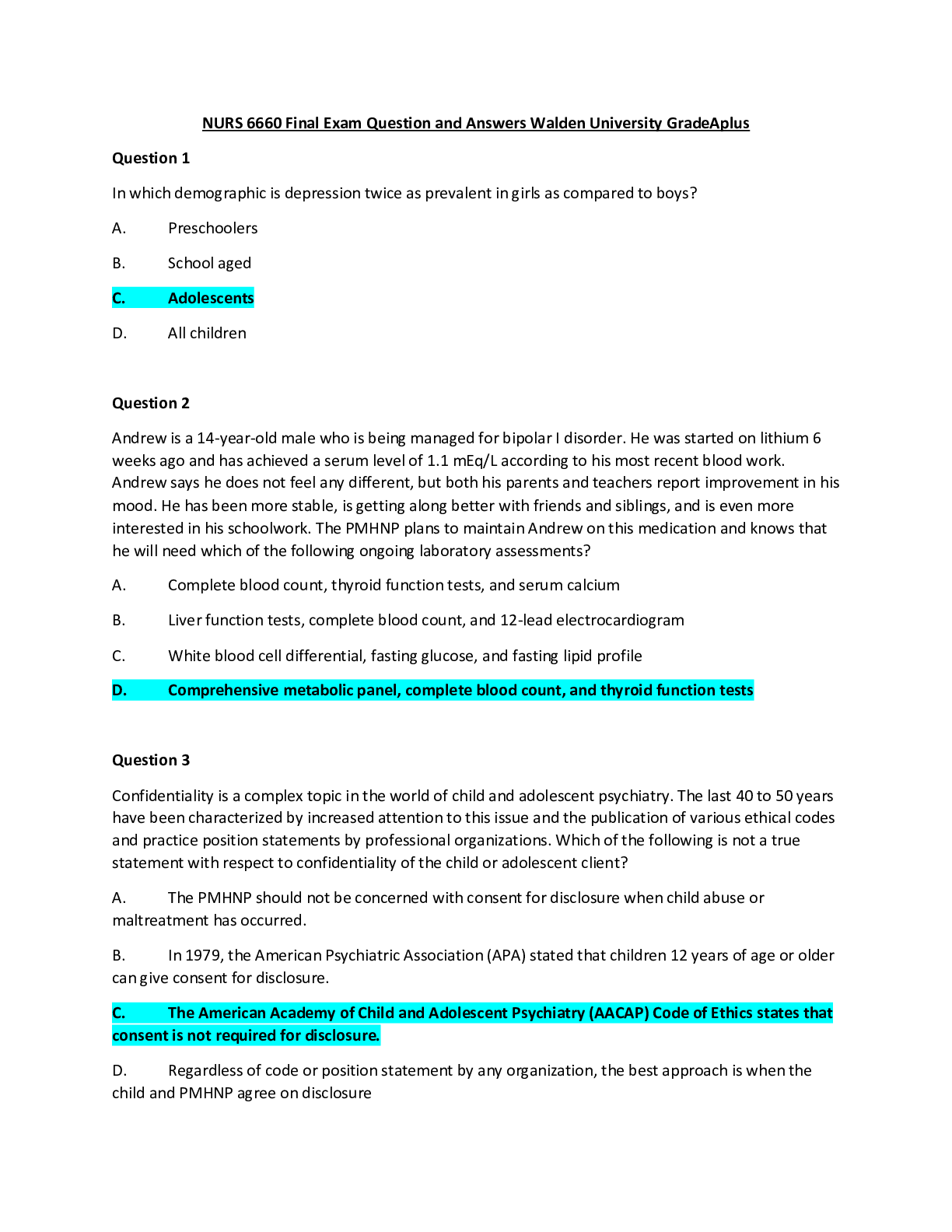
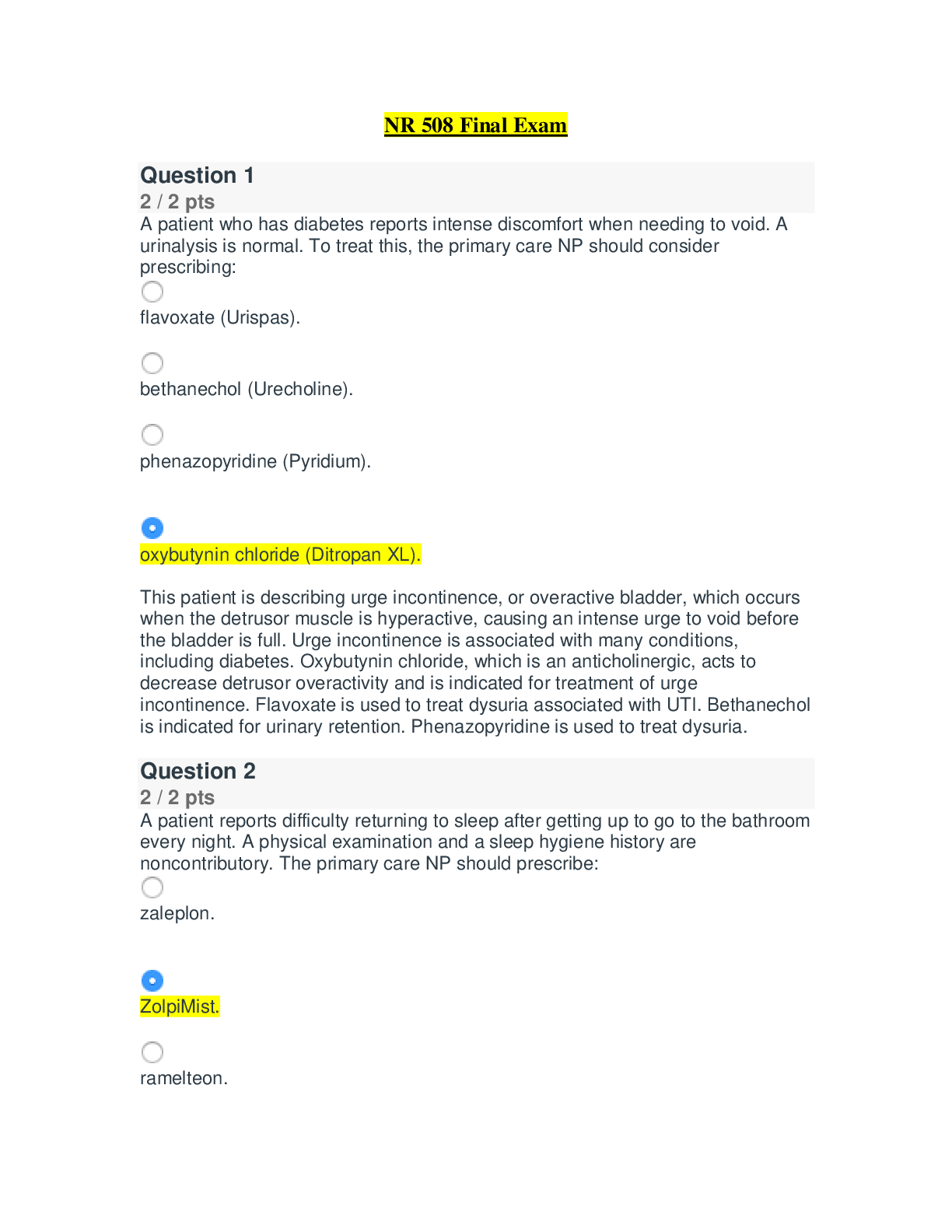
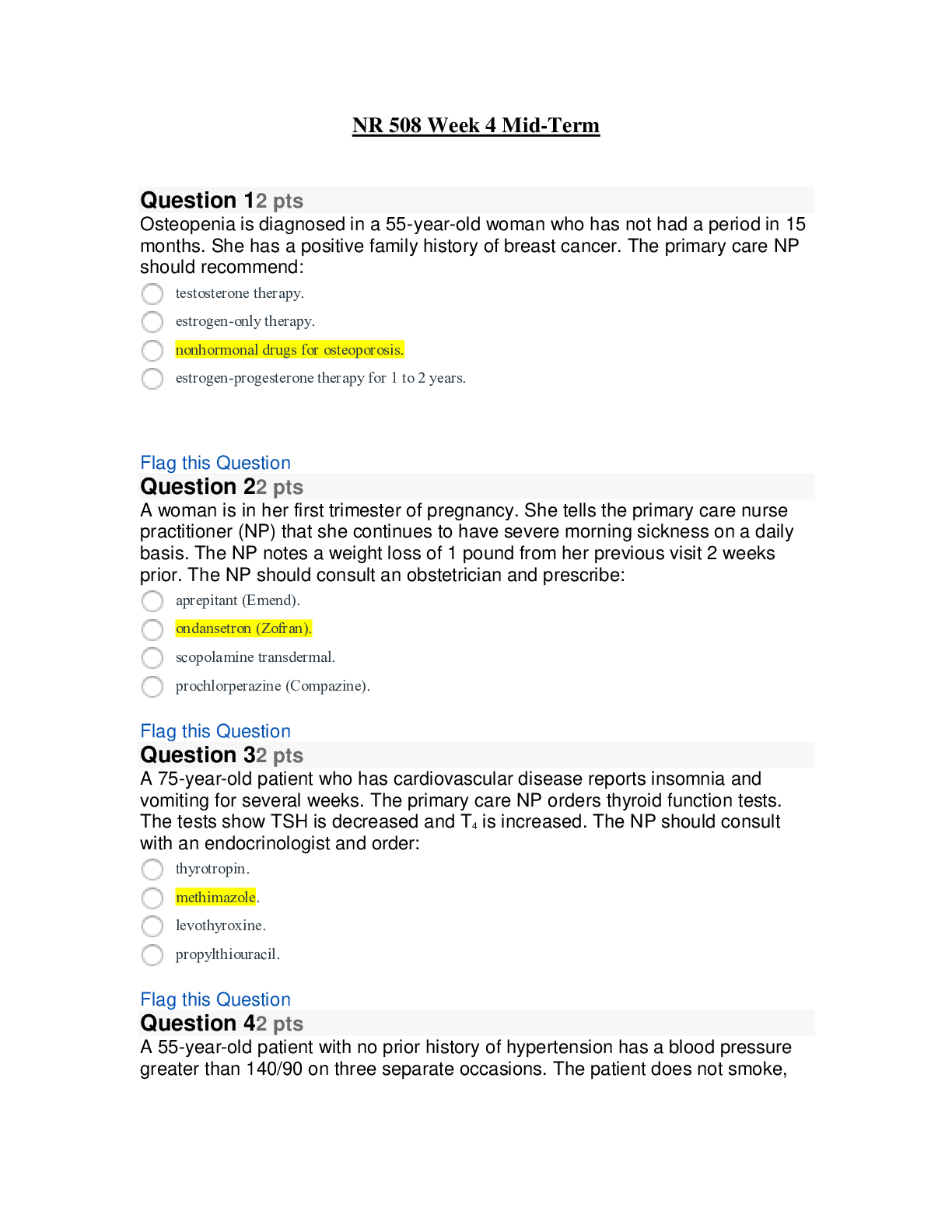
.png)
.png)
